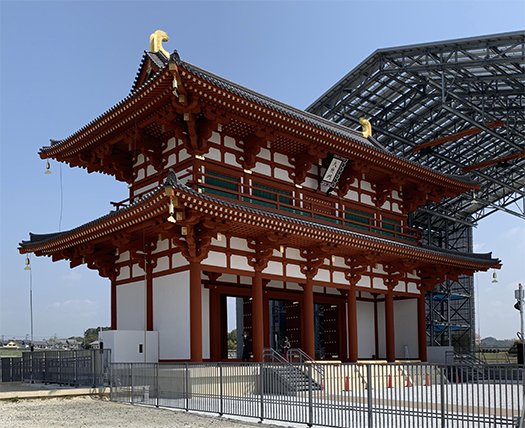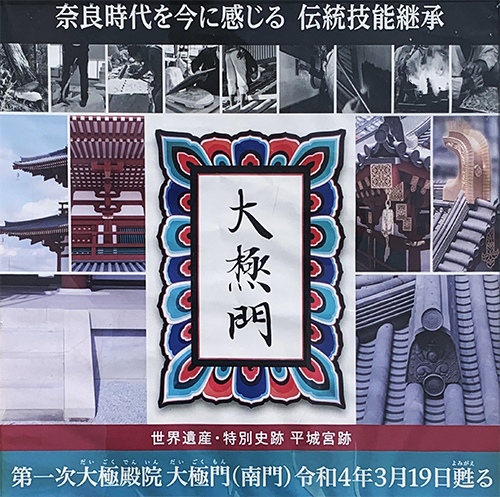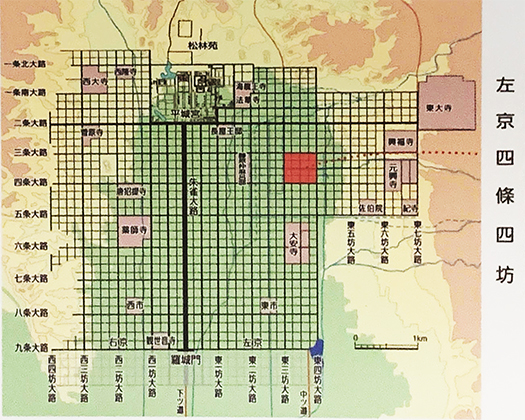


さて昨日は奈良県シリーズから賀茂神社つながりで遠く北海道知内町に。
で、賀茂神社系の話題展開はあまり大きな進展がなく
むしろ鎌倉期の甲州からの産金事業者軍団の北海道での活動ぶりに
スポットを当てた記録が友人読者の助けもあって掘り出されてきた。
わたし的には蝦夷ヶ島での産金活動を支えた鎌倉政権の意志形成と背景について
非常に大きな興味を抱かされた。追ってそのあたりを探究してみたい。
ということで奈良シリーズに復帰いたします。ほっ・・・。
飛鳥京からその近傍「藤原京」への遷都があってから短期間で、
古代における本格的計画都市として平城京建設が進行していった。
経済史的にはこの平城京建設の時代は歴史上まれに見る好景気だったといわれる。
乙巳の変、白村江敗戦、壬申の乱とうち続いた戦乱が収まり、
仏教導入・律令制による王権の全国一律支配体制が経済の活況も生み出した。
ものの集散において中央集権機構が機能することで
経済の活況が必然的に生み出されたということだろう。
「官道」整備も進められ全国的物流機構が整備されたことも大きかったと思う。
やや時代が下ると東大寺大仏「鍍金」の必要に対し金が奥州で発見された。
金を入手するのに唐との遣唐使船交易を計画せねばならないとされたが
その必要がなくなって、逆に世界最大級の産金国家として
マルコポーロ経由でヨーロッパ世界にまでジパングの国名がとどろいた。
この時代にすでに「経済国家」的な立ち位置を日本は占めていた。
そういう時代背景の中でまさに国家創設の建設事業がこの平城京建設。
札幌は条丁という都市区割りですが、平城京は「条坊制」。
しかしどちらも基本は碁盤の目状の合理的都市区画設計。

日本では奈良、京都、大阪、江戸、東京、札幌と
計画的都市建設の歴史伝統がうち続いていくけれど、
その嚆矢として奈良・平城京ははじめての本格的開発だったのだろうと思う。
王権がそのように意志を固め「公共事業」というものに本腰を入れた。
公共投資は経済の活況を生み出し、租税収入も上がっていったし
民の経済活動が大いに刺激されて、望外の結果として国運も上がり
奥州産金という奇跡まで呼び込んだという状況ではないか。
この平城京は歴史公園事業として復元計画が進められている。
まだ本格的な整備には時間が掛かるようですが、写真のように
大極殿の門とされる「大極門」の仮設足場も撤去寸前という状況での見学。
広大な王城空間の復元ぶりは建築人としては興味津々といったところです。
清水建設や竹中組といった大手ゼネコン施工で整備が進んでいる。
さすがに公共事業なので情報開示も民主的に行われています。
整備計画の進展を見ながら、できれば今後も見学機会を作って
民族と建築営為の象徴的断面として推移を見ていきたいと思う次第。
English version⬇
Heijo-kyo Capital, Nara, Japan: Searching for the Heijo-kyo Capital – 17
Ethnic history and economic traces. Japan’s first full-scale public works investment, the construction of the capital, and the economic boom that ensued. The dynamism of the huge architectural complex. Nara Heijo-kyo Capital
Yesterday, we went from the Nara Prefecture series to the distant town of Chonai, Hokkaido, in connection with Kamo Jinja.
The Kamo Jinja-related topics did not develop very much.
Rather, with the help of a reader friend of mine, I was able to dig up a record that spotlighted the activities of a group of gold-producing businessmen from Koshu in Hokkaido during the Kamakura period.
The records that spotlighted the activities of the Koshu gold-producing businessmen in Hokkaido during the Kamakura period have been unearthed with the help of a reader friend of mine.
So I will return to the Nara series. Ho-ho-ho…
Within a short period of time after the transfer of the capital from Asuka-kyo to the nearby Fujiwara-kyo, the construction of Heijo-kyo proceeded as a full-scale planned city in ancient times.
Heijo-kyo Capital was constructed as a full-scale planned city in ancient times.
From an economic historical perspective, the Heijo-kyo Capital construction period is said to have been one of the most prosperous in history.
After the warfare that had continued, including the Otomi Incident, the defeat at the Hakumura River, and the Jinshin Rebellion, the introduction of Buddhism and the Ritsuryo system brought about a period of economic growth that was unprecedented in history.
The introduction of Buddhism and the Ritsuryo system, a system of uniform rule by the royal authority throughout the country, also brought about a booming economy.
The centralization of power in the collection and dispersion of goods
The centralization of power in the collection and distribution of goods inevitably led to a boom in the economy.
The development of “government highways” and the establishment of a nationwide logistics system were also important.
A little later, gold was discovered in Oshu to meet the need for “plating” the Great Buddha of Todaiji Temple.
It was said that a plan to trade with the Tang Dynasty in order to obtain gold had to be made, but that plan was no longer necessary.
However, this was no longer necessary, and the Japanese were able to become one of the world’s largest gold-producing nations.
The name “Zipangu” was known to the European world via Marco Polo.
At this time, Japan already occupied the position of an “economic nation.
Against this backdrop, the Heijo-kyo Capital was built as a construction project to establish the nation.
Sapporo was divided into city blocks called “jyocho,” while Heijo-kyo Capital was built under the “joubo” system.
However, the basic concept of both Heijo-kyo Capital and Sapporo is a rational urban district design in the form of a goban (a grid pattern).
In Japan, the historical tradition of planned city construction continues in Nara, Kyoto, Osaka, Edo, Tokyo, and Sapporo.
Nara, Kyoto, Osaka, Edo, Tokyo, Sapporo, and so on.
I believe that the Heijo-kyo Capital in Nara was the first full-scale development of such a pioneering project.
The royal court had made up its mind to do so, and began to seriously engage in “public works”.
Public investment created a booming economy, tax revenues rose, and the people’s economic activity was greatly stimulated.
The economic activities of the people were greatly stimulated, and as an unexpected result, the nation’s fortunes rose.
The situation even brought about the miracle of the Oshu gold mine.
This Heijo-kyo Palace is being planned for restoration as a historical park project.
It seems that it will still take some time for full-scale maintenance, but as you can see in the photo
The temporary scaffolding of the Daigoku-mon Gate, which is considered to be the gate to Daigoku-den, was also on the verge of being removed, as you can see in the photo.
As an architect, I was very interested in the restoration of the vast royal castle space.
Major general contractors such as Shimizu Corporation and Takenaka Corporation are constructing the gate.
As one would expect from a public project, information disclosure is carried out democratically.
We will continue to watch the progress of the maintenance plan and, if possible, create opportunities to visit the site in the future.
I would like to see the transition of the building as a symbolic cross section of ethnic and architectural activities.
Posted on 5月 3rd, 2022 by 三木 奎吾
Filed under: 住宅マーケティング, 日本社会・文化研究







コメントを投稿
「※誹謗中傷や、悪意のある書き込み、営利目的などのコメントを防ぐために、投稿された全てのコメントは一時的に保留されますのでご了承ください。」
You must be logged in to post a comment.